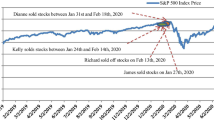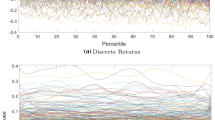Abstract
The motivation for this article is to show the usefulness of the information contained in the open-to-close (day) and close-to-open (night) periods compared to the more frequently used close-to-close period. To show this we construct two versions of a contrarian strategy, where the worst performing shares during the day (resp. night) are bought and held during the night (resp. day). We show that the strategies presented here generate a significant α and their returns cannot be solely explained by the factors derived from Fama and French (1993) 3-factor model and a modified 5-factor model introduced by Carhart (1997). Even after we account for the bid-ask bounce effect, the returns generated are significant and consistent. The information ratios of the two strategies mentioned for the entire period 2000–2010 vary between 1.59 and 6.70 depending on the capitalization of stocks. Overall, we show that opening prices contain information that is not generally fully utilized yet. The strategy proposed uses this information to add value and extract a significant α, which cannot be explained by market factors.
Similar content being viewed by others
Notes
In this article, the information ratio is calculated as the ratio of annualized return to annualized standard deviation, see Appendix A.
For instance, see interactivebrokers.com/en/p.php?f=commission&ib_entity=llc where the fee is USD 0.0035 per share, which amounts to 0.05 per cent if the nominal value of share is USD 7. Note that the fee decreases proportionally as the nominal value of the share increases.
References
Bali, T.G., Demirtas, K.O. and Levy, H. (2008) Nonlinear mean-reversion in stock prices. Journal of Banking and Finance 32 (5): 767–782.
Carhart, M.M. (1997) On persistence in mutual fund performance. The Journal of Finance 52 (1): 57–82.
Choi, H.S. and Jayaraman, N. (2009) Is reversal of large stock-price declines caused by overreaction or information asymmetry: Evidence from stock and option markets. Journal of Futures Markets 29 (4): 348–376.
Cliff, M.T., Cooper, M.J. and Gulen, H. (2008) Return differences between trading and non-trading hours: Like night and day. SSRN eLibrary, http://ssrn.com/paper=1004081.
De Gooijer, J.G., Diks, C.G. and Gatarek, L.T. (2009) Information flows around the globe: Predicting opening gaps from overnight foreign stock price patterns. SSRN eLibrary, http://ssrn.com/paper=1510069.
Fama, E.F. (1997) Market efficiency, long-term returns, and behavioral finance. SSRN eLibrary, http://ssrn.com/paper=15108.
Fama, E.F. and French, K.R. (1992) The cross-section of expected stock returns. The Journal of Finance 47 (2): 427–465.
Fama, E.F. and French, K.R. (1993) Common risk factors in the returns on stocks and bonds. Journal of Financial Economics 33 (1): 3–56.
Forner, C. and Marhuenda, J. (2003) Contrarian and momentum strategies in the Spanish stock market. European Financial Management 9 (1): 67–88.
Gaunt, C. and Nguyen, J. (2008) Stock returns following large one-day declines: Further evidence on the liquidity explanation from a small, developed market. SSRN eLibrary, http://ssrn.com/paper=495244.
Hong, H. and Wang, J. (2000) Trading and returns under periodic market closures. The Journal of Finance 55 (1): 297–354.
Khandani, A.E. and Lo, A.W. (2007) What happened to the quants in August 2007? Journal of Investment Management 5 (4): 5–54.
Kim, M.J., Nelson, C.R. and Startz, R. (1991) Mean reversion in stock prices? A reappraisal of the empirical evidence. The Review of Economic Studies 58 (3): 515–528.
Leung, W.K. (2009) Price Reversal and Firm Size in the U.S. Stock Markets, New Evidence, Proceedings of the World Congress on Engineering; 1–3 July 2009, London, Engineers, I. A. O.
Lo, A.W. and Mackinlay, A.C. (1990) When are contrarian profits due to stock market overreaction? The Review of Financial Studies 3 (2): 175–205.
Mazouz, K., Joseph, N.L. and Joulmer, J. (2009) Stock price reaction following large one-day price changes: UK evidence. Journal of Banking & Finance 33 (8): 1481–1493.
Mcinish, T.H., Ding, D.K., Pyun, C.S. and Wongchoti, U. (2008) Short-horizon contrarian and momentum strategies in asian markets: An integrated analysis. International Review of Financial Analysis 17 (2): 312–329.
Morse, D. and Ushman, N. (1983) The effect of information announcements on the market microstructure. The Accounting Review 58 (2): 247–258.
Park, J. (1995) A market microstructure explanation for predictable variations in stock returns following large price changes. The Journal of Financial and Quantitative Analysis 30 (2): 241–256.
Serletis, A. and Rosenberg, A.A. (2009) Mean reversion in the U.S. stock market. Chaos, Solitons & Fractals 40 (4): 2007–2015.
Sharpe, W.F. (1964) Capital asset prices: A theory of market equilibrium under conditions of risk. Journal of Finance 19 (3): 425–442.
Thaler, R. and De Bondt, W.F.M. (1985) Does the stock market overreact? The Journal of Finance 40 (3): 793–805.
Author information
Authors and Affiliations
Corresponding author
Appendices
Appendix A
Appendix B
Table B1. Version 1 of the strategy applied to the constituent stocks of the S&P 400 MidCap Index. Decision period is from today's close to the next day's open and holding period from the next day's open to the next day's close. The results are divided into deciles. The first decile contains the worst performing shares during the decision period, the tenth decile the best ones.
Appendix C
Table C1. Version 2 of the strategy applied to the constituent stocks of the S&P 400 MidCap Index. Decision period is from today's open to today's close and holding period is from today's close to the next day's open. The results are divided into deciles. The first decile contains the worst performing shares during the decision period, the tenth decile the best ones.
Appendix D
Table D1. Version 1 of the strategy applied to the constituent stocks of the S&P 500 Index. Decision period is from today's close to the next day's open and holding period from the next day's open to the next day's close. The results are divided into deciles. The first decile contains the worst performing shares during the decision period, the tenth decile the best ones.
Appendix E
Table E1. Version 2 of the strategy applied to the constituent stocks of the S&P 400 MidCap Index. Decision period is from today's open to today's close and holding period is from today's close to the next day's open. The results are divided into deciles. The first decile contains the worst performing shares during the decision period, the tenth decile the best ones.
Appendix F
Appendix G
Appendix H
Appendix I
Rights and permissions
About this article
Cite this article
Dunis, C., Laws, J. & Rudy, J. Profitable mean reversion after large price drops: A story of day and night in the S&P 500, 400 MidCap and 600 SmallCap Indices. J Asset Manag 12, 185–202 (2011). https://doi.org/10.1057/jam.2011.15
Received:
Revised:
Published:
Issue Date:
DOI: https://doi.org/10.1057/jam.2011.15




